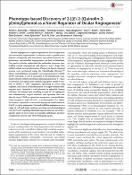Options
Phenotype-based Discovery of 2-[(E)-2-(Quinolin-2-yl)vinyl]phenol as a Novel Regulator of Ocular Angiogenesis
Date Issued
2016-04-01
Date Available
2018-04-11T12:46:52Z
Abstract
Retinal angiogenesis is tightly regulated to meet oxygenation and nutritional requirements. In diseases such as proliferative diabetic retinopathy and neovascular age-related macular degeneration, uncontrolled angiogenesis can lead to blindness. Our goal is to better understand the molecular processes controlling retinal angiogenesis and discover novel drugs that inhibit retinal neovascularization. Phenotype-based chemical screens were performed using the ChemBridge DiversetTM library and inhibition of hyaloid vessel angiogenesis in Tg(fli1:EGFP) zebrafish. 2-[(E)-2-(Quinolin-2-yl)vinyl]phenol, (quininib) robustly inhibits developmental angiogenesis at 4–10 μm in zebrafish and significantly inhibits angiogenic tubule formation in HMEC-1 cells, angiogenic sprouting in aortic ring explants, and retinal revascularization in oxygen-induced retinopathy mice. Quininib is well tolerated in zebrafish, human cell lines, and murine eyes. Profiling screens of 153 angiogenic and inflammatory targets revealed that quininib does not directly target VEGF receptors but antagonizes cysteinyl leukotriene receptors 1 and 2 (CysLT1–2) at micromolar IC50 values. In summary, quininib is a novel anti-angiogenic small-molecule CysLT receptor antagonist. Quininib inhibits angiogenesis in a range of cell and tissue systems, revealing novel physiological roles for CysLT signaling. Quininib has potential as a novel therapeutic agent to treat ocular neovascular pathologies and may complement current anti-VEGF biological agents.
Sponsorship
Health Research Board
Science Foundation Ireland
Other Sponsorship
Enterprise Ireland
Type of Material
Journal Article
Publisher
American Society for Biochemistry and Molecular Biology
Journal
Journal of Biological Chemistry
Volume
291
Issue
14
Start Page
7242
End Page
7255
Copyright (Published Version)
2016 The American Society for Biochemistry and Molecular Biology
Language
English
Status of Item
Peer reviewed
This item is made available under a Creative Commons License
File(s)
Loading...
Name
J._Biol._Chem.-2016-Reynolds-7242-55.pdf
Size
4.36 MB
Format
Adobe PDF
Checksum (MD5)
75947fe90fbb936748f3262165aaaa30
Owning collection
Mapped collections